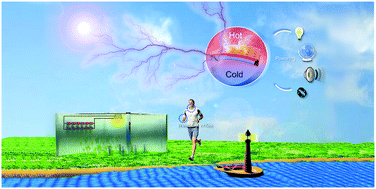Vapor and heat dual-drive sustainable power for portable electronics in ambient environments†
Abstract
Ubiquitous vapor and low-grade heat are widely available in nature and provide abundant, clean sources for developing new types of power generators. Herein, we demonstrate high-performance power, driven by vapor and heat for portable electronics in ambient environments. Based on the ternary aggregate of a polyelectrolyte, conducting polymer and a redox couple, the vapor and heat dual-drive electric generator (VHG) of 1 cm2 offers an open circuit voltage of 0.9 V, and a sustainable short-circuit-current density of up to 0.8 mA cm−2, much higher than that of single-source generators. Resulting from synergistic double-acting ion migration and the thermogalvanic effect, the high-efficiency VHG can work as a flexible personal energy-supply system to support wearable devices, such as hearing aids, by using body sweat and heat. It can even light a 15 W bulb once compatibly installed in a greenhouse. This work paves the way for sustainable energy generation by effectively collecting multiple types of natural energy comprehensively to realize sustainable applications in different seasons and geographical locations.



 Please wait while we load your content...
Please wait while we load your content...